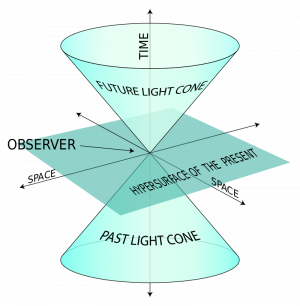The Theory of Relativity is two interlinked theories on space, time, and gravity published by Albert Einstein. He published Special Relativity in 1905 and General Relativity in 1916.
Special Relativity
Special Relativity is called such because it covers special cases, including super-fast speeds, huge amounts of energy, and immense distances in space, without involving gravity in the discussion.
Special Relativity is based on two premises:
- There is no “real” or preferred frame of reference, no standard observation point. When an object moves along a straight path at a constant speed, the laws of physics stay the same for all objects that move along a straight path at an unchanging speed. For instance, when a person is on a train and looks out the window and sees another nearby train in an apparent forward motion, the person will have a hard time figuring out whether his train is the one that is moving or if it is indeed the nearby train. Einstein explained that if the two trains were moving slowly at the same speed, it would be impossible for the person to tell. Einstein recognized this hypothetical situation as a fundamental problem of physics.
- Light travels at a constant speed of 299,792.458 kilometers per second. This speed at which light travels stays the same no matter how fast an observer moves or how fast a light-radiating object is moving.
Using these two premises, Einstein illustrates that time and space are interwoven in ways that humans have never understood before. By way of thought experiments, he showed that the implications of special Relativity baffle conventional human logic:
Assume you’re inside a space observatory, and a friend in a spaceship traveling at 99 percent the speed of light hurtles past you. You will see that the clock inside his spaceship is ticking twice as slow compared to your clock. This is because clocks traveling close to the speed of light slow down. However, this slowing down can only be seen by an external observer who is not traveling at the same speed. Physicists identified this phenomenon as time dilation.
The same spaceship will also appear to you as shorter than its actual size. This shortening is caused by the spaceship’s mass, which is resisting the tremendous speed at which it is moving. This is called length contraction. Einstein stated that any object with mass could never attain the speed of light.
Another outcome of Special Relativity is that energy and matter are equal and can be changed from one form to another. This is expressed in Einstein’s equation, E = mc², where E means energy, m stands for mass, and c² is the speed of light multiplied by itself. The speed of light is a large number, and so it necessarily follows that just a minute quantity of mass can be transformed into an enormous magnitude of energy.
Special Relativity also affects the notion of simultaneity. Suppose two events seem to have happened simultaneously to one observer. In that case, those two events may not seem to have happened at the same time to another observer if the two observers are in motion relative to each other.
General Relativity
General Relativity is a theory of gravity. This theory illustrates gravity as not merely an unseen force but a force that is generated by the mass of an object. This force, in turn, attracts other objects and forces the surrounding space to curve. The more massive an object is, the more curved the space around it becomes. It is very much the same if you place a bowling ball on a stretched fabric. The bowling ball would sink into the fabric and create a depression. If you drop a marble on the edge of the fabric, the marble will not stay on the edge, but instead, fall toward the bowling ball. This is how a massive object in space attracts objects of lesser size by way of its mass.
The curving of space caused by gravity also slows downtime. Time is viewed as passing at an unchanging rate in everyday life on Earth. However, gravity not only alters space it also alters time. The more massive an object is, the slower time flows around it. If you can picture your friend sitting on top of Mount Everest, you will see that his clock is running a bit faster compared to your clock. This is caused by your friend’s being located farther from Earth’s mass. If you send another friend to a low-lying area, his clock will run slower than your friend at the summit. This is because your friend in the low-lying area is closer to Earth’s mass. However, these differences will be almost imperceptible because of the weakness of Earth’s gravity, although these phenomena have already been confirmed by experiments and highly-sensitive instruments.
The gravitational force acting between two objects is dependent on two factors: how massive the two objects are and the distance between them. While a person stands on the ground, he is clearly pulled by Earth towards its center; that is why he is not floating upwards towards the sky. However, the person’s center of gravity is pulling at Earth at the same time. In this case, the person is the object with the lesser mass, and so he is the one who feels the pull of the more massive object, evidenced by his feet remaining on the ground.
As space becomes curved around massive objects, the light that passes through that curved space becomes curved as well. A good example where light becomes bent is at the edge of a black hole. The black hole is very massive and, therefore, very dense, that space and therefore light cannot escape its pull.
In the past century, physicists have conducted experiments testing the soundness of both special and general relativity. So far, the two sets of theories have proven to be valid. In 1919, general Relativity proved its validity when astronomers accounted for the light deflected by stars as it passed by the Sun. This proved that strong gravitational forces indeed bend the space around it.

